6
Vehicle Power and Large Weapon Systems
INCREASING WEIGHT AND POWER REQUIREMENTS
History has shown that combat vehicles undergo a significant weight increase as new capabilities are added. Whereas the original Abrams M1 started out as a 54-ton vehicle, the latest versions of the Abrams now weigh more than 70 tons due to added armament, weaponry, and electronics. With advanced technologies adding new capabilities every day, this trend is likely to continue as multi-domain operations (MDO) mature.
PRESENT ARMY POWER PACK USAGE
The Army today uses a variety of power packs, some of which utilize commercial off-the-shelf (COTS) engines and transmissions modified for the military, and others with unique military-specific designs. On COTS engines, emission-related hardware is typically removed due to lower emissive requirements. Unique military-specific power packs provide higher performance, but are typically higher cost due to lower production volumes. As time progresses, the differences between the automotive industry’s COTS powertrains and the military market needs have been diverging and likely will continue to diverge as shown in Figure 6.1.
Unfortunately, many of the engines now deployed on Army vehicles and generators have not kept pace with the latest truck original equipment manufacturer (OEM) fuel-efficiency advancements. For example,
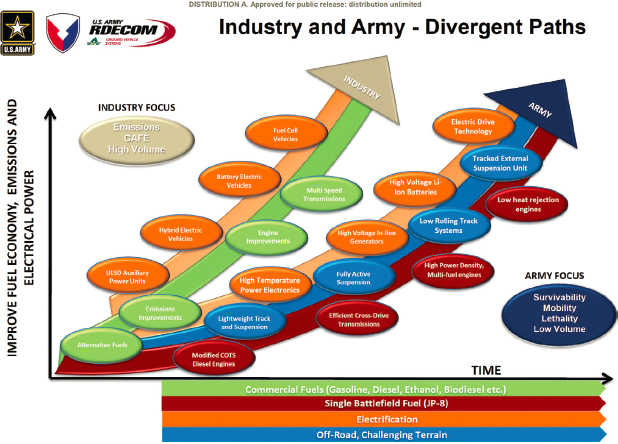
Cummins, Daimler, Navistar, and Volvo have all demonstrated a capability to provide more than 50 percent brake thermal efficiency on their Department of Energy (DOE)-sponsored SuperTruck projects.1,2
Weichai, a Chinese engine manufacturer, also recently announced that it has introduced into production a 13 L, 417 kW truck engine that has achieved 50.26 percent brake thermal efficiency.3 They noted that this was
___________________
1 D. Villeneuve and J. Girbach, 2020, “Improving Transportation Efficiency Through Integrated Vehicle, Engine, and Powertrain Research - SuperTruck 2,” Daimler Trucks North America, https://www.energy.gov/sites/prod/files/2020/05/f75/ace100_Villeneuve_2020_o_4.29.20_250pm_TDM.pdf.
2 J. Dickson and K. Damon, 2020, Cummins/Peterbilt SuperTruck II joint presentation at the 2020 DOE Annual Merit Review.
3 Weichai America, 2020, “Weichai Launches a 50% BTE Diesel Engine.” https://www.weichaiamerica.com/index.php/news-and-events.
made possible by a $4.4 billion investment in diesel engine development over 10 years.
PRESENT ARMY INTERNAL POWER PACK DEVELOPMENT PROGRAMS
To address the ongoing need to maintain or improve vehicle performance as well as to improve fuel efficiency, the Army has undertaken a number of active power pack design and development programs unique to the military. These include the following:
- Advanced Powertrain Demonstrator (APD)—which includes the following components:
- Advanced Combat Engine (ACE; TRL 5)
- Advanced Combat Transmission (ACT; TRL 6)
- Advanced Thermal Management System (ATM; TRL 6)
- APD Integrated Starter/Generator (AISG; TRL 6)
- Projected Propulsion System (TRL 4)
- Advanced Mobility Experimental Prototype (AMEP; TRL 5)
- Platform Electrification Mobility (TRL 4)
Each of these programs will enhance the power density, fuel efficiency, and/or thermal signature of military power packs. Additional information regarding the content and functional benefits of each of the above programs is contained in Chapter 8, “Fuel Conversion Efficiency and Other Material Driven Opportunities.”
Recommendation: The Army has undertaken a number of internal vehicle power plant programs (Advanced Powertrain Demonstrator, Projected Propulsion System, Advanced Mobility Experimental Prototype, and Platform Electrification Mobility) that will significantly enhance the Army’s operational capabilities in a multi-domain operations environment. The committee recommends that their funding and timing continue as presently planned.
U.S.-JAPAN PROJECT AGREEMENT STRYKER
The Army’s Ground Vehicle Systems Center (GVSC) also will be executing a parallel hybrid Stryker architecture building off of the Vehicle Electric Architecture (VEA) Mobile Demonstrator (VMD)/Advanced Propulsion with On-board Power (APOP II) development. Development of this hybrid system is part of a U.S./Japan Project Agreement that will launch in 2021. It adds a clutch, high-voltage energy storage (about 350V DC), and DC/DC converter to move power between the high-voltage
energy storage and the 600 VDC (volts direct current) vehicle power bus. The system is expected to provide approximately 3 miles of silent mobility, 40 percent improved acceleration, 30–35 percent reduced fuel use, and 15 percent improved speed on grade.4
JP8/DIESEL FLEX FUEL CAPABILITY (AN OPPORTUNITY TO SHORTEN THE FUEL SUPPLY LINE)
With funding, the technology exists today that would make it possible to design an internal combustion engine that provides optimal operation while running with a variety of fuels. One of the simplest capabilities to implement would be adding a capability to run DF1 diesel, DF2 diesel, and/or biodiesel fuels on an engine designed for jet propellant 8 (JP8). Because of the different cetane values, density, and energy content of these fuels, closed-loop combustion control of fuel injection timing and quantity (or air/fuel ratio) would make this possible. One approach popular within today’s automotive market is to use control algorithms based on readings from in-cylinder pressure sensors.5 In addition, the Army’s Vehicle Technologies Office is studying alternative, less intrusive (and possibly more reliable) approaches to determine the start of combustion, including use of knock/accelerometer sensors and crankshaft acceleration measurements. Feasibility for such alternatives has not yet been demonstrated.
Because DF2 has roughly 9 percent more energy content by volume than JP8, in battlefield situations where climatic conditions allow use of DF2, roughly 9 percent less fuel would need to be transported to complete a given mission with DF2 than JP8. In addition, by optimizing the injection timing and mass fraction burned as a function of crank angle for any fuel used, the engine’s torque, fuel efficiency, and cold-start capability would be enhanced. As a result, the range of each ground combat vehicle would be increased by more than the above cited 9 percent. Lastly, it may be possible to find local sources of DF2 on or near the battlefield, shortening the supply line even further.
It should be noted that one concern with locally supplied diesel is the amount of biodiesel it contains. Given studies done by OEMs and the major diesel injector suppliers, percentages up to 20 percent should not be of concern, provided they are not stored for more than a year.6 However,
___________________
4 D. McGrew, U.S. Army CCDC Ground Vehicle Systems Center, 2020, Email exchange with individual committee member.
5 Such systems are available on Audi, Opel, Isuzu, and Volkswagen vehicles.
6 T. Alleman, R.L. McCormick, E.D. Christensen, G. Fioroni, K. Moriarty, and J. Yanowitz, 2016, Biodiesel Handling and Use Guide (Fifth Edition), U.S. Department of Energy, https://afdc.energy.gov/files/u/publication/biodiesel_handling_use_guide.pdf.
in some overseas markets, biodiesel percentages exceed this. In such cases, the Army could revert to its presently planned JP8 use.
Conclusion: The use of DF2 in lieu of JP8 could reduce the fuel supply line due to its higher energy density, which would decrease the number resupply missions required to sustain the operational units. Although this violates the Army’s present “single fuel policy” and will present some added logistics complexity challenges, further consideration by the Army is warranted. (Tier 1, Lead)
Recommendation: The Army should consider using closed-loop combustion control in all new engine designs as these engines, properly calibrated, could allow seamless operation between jet propellant 8 (JP8), diesel, and biodiesel while simultaneously increasing fuel efficiency while using JP8. (Tier 1, Lead)
JP8/GASOLINE FLEX FUEL CAPABILITY
Adding a capability to run gasoline to the list of allowable fuels for a compression ignition engine is also theoretically possible although difficult to implement. Multiple industry efforts are under way on gasoline compression ignition (GCI), including one sponsored by DOE’s Advanced Research Projects Agency-Energy (ARPA-E).7 GCI studies are also part of Navistar’s SuperTruck program.8 The same direct fuel injection system could be used for JP8, diesel, and gasoline. When running gasoline, a higher compression ratio would be desirable than when running diesel because of the latter’s reduced ignitability. Several approaches to vary compression ratio in a running engine now exist. As one example, Infiniti has a continuously variable system in production. As another, Germany’s IWIS Group has a simpler “bang/bang” compression ratio system going into production in 2023.9
Another approach that might enable use of gasoline in a diesel engine without modifying the compression ratio is to use spark plug assistance. Mazda’s Skyactive-X spark-assisted gasoline compression ignition engine provides such an example, with its 16.3:1 compression ratio. Potentially, use of Tenneco’s Advanced Corona Ignition system, which provides
___________________
7 ARPA-e, 2015, “Efficient Engine Design,” Achates Power, https://arpa-e.energy.gov/technologies/projects/efficient-engine-design.
8 J. Cigler, D. Oppermann, 2020, “Navistar SuperTruck II: Development and Demonstration of a Fuel-Efficient Class 8 Tractor & Trailer,” presented at the 2020 Department of Energy Merit Review, Navistar, Inc., https://www.energy.gov/sites/prod/files/2020/05/f75/ace103_%20zukouski_2020_o_4.27.20_108PM_LR.pdf.
9 IWIS, 2020, “Dual Mode VCS,” https://www.dual-mode-vcs.com/en, accessed November 2020.
25 mm–long ionized streamers to initiate ignition might provide some added capability.10
Both modifications (i.e., changing compression ratio or adding spark ignition) would require new engine designs. The benefits of fuel flexibility between JP8 and gasoline also may not be that significant, because it is likely that locally procured diesel is available in most world markets wherever locally procured gasoline would be available.
For unmanned aircraft systems, the Army is presently studying what is called a “variable energy–assisted ignition assistant.” Essentially, it consists of a temperature-controlled glow plug that is energized throughout the engine’s operation. A hot surface is created that assists autoignition of one of the diesel injector plumes, which in turn creates the added pressure and temperature needed to ignite the other plumes. This ignition assist may enhance the ability to use gasoline and other low cetane fuels under high-altitude pressure and temperature conditions.
Conclusion: It is possible with substantial changes to design an engine that can run gasoline or diesel fuel interchangeability; however, the operational advantages such a capability would provide are judged to be small.
OTHER POTENTIAL JP8/GASEOUS-ICE FUEL AND FLEX-FUEL APPLICATIONS
Adding a capability to run propane, compressed natural gas/methane, or hydrogen in the same engine as JP8 is also possible. Each gaseous fuel is introduced to the engine with low pressure either in the intake manifold or engine intake ports or high pressure directly into the combustion chamber. Combustion is initiated either with a spark plug (or possibly two) in the combustion chamber combined with a high-energy ignition system or with a diesel pilot injection. Challenges that need to be addressed include possible incomplete combustion at light loads and possible knock/detonation at higher loads.
Wärtsilä, MAN Energy Systems, and Fairbanks-Morse already have dual-fuel (diesel and gas) engines in production, albeit in larger engines used for stationary power. The earliest of these were introduced back in 1995.11,12,13
___________________
10 Tenneco Powertrain, Undated, “ACIS - Advanced Corona Ignition System,” http://www.federalmogul.com/en-US/OE/Products/Pages/Product-Details.aspx?CategoryId=15&SubCategoryId=21&ProductId=224, accessed November 2020.
11 Wärtsilä, Undated, “Dual-Fuel Engines from Wärtsilä,” https://www.wartsila.com/encyclopedia/term/dual-fuel-engines-from-w%C3%A4rtsil%C3%A4, accessed January 2021.
12 Ibid.
13 Ibid.

Conclusion: Although technically possible, given the lower energy density of gaseous fuels and associated transport concerns, it is not recommended that mobile JP8/gaseous dual fuel engines be pursued.
FREE-PISTON ENGINES
A free-piston engine is a linear internal combustion engine in which the piston motion is not controlled by a crankshaft but instead determined by the interaction of forces from combustion chamber gases, an oscillator or rebound device (e.g., a gas spring chamber), and a linear alternator (see Figure 6.2).
Attractive features of a free-piston engine include the following: (1) direct conversion of piston motion into electrical energy, (2) no frictional losses from crank-slider and generator mechanisms, (3) reduced power cylinder losses because no side forces are exerted on the piston by a connecting rod, (4) variable compression ratio, and (5) electrical energy capture on both the compression and expansion strokes.
Historically, challenges arose with precisely controlling the piston’s position, which now is overcome with newer control systems. A number of companies are presently looking to commercialize this technology. Toyota is looking at using this technology as a range extender in a gasoline or diesel-powered passenger car application.14 Toyota says this mechanically simple engine achieves a claimed gasoline thermal-efficiency rating of 42 percent in continuous use, which compares favorably with the best gasoline engines under development today. As a two-cylinder engine, the free-piston engine is inherently balanced with a size of roughly 8 in. around and 2 ft long. An engine of that size and type could generate roughly 11 kW, enough to move a compact electric vehicle at highway speeds after its main drive battery has been depleted.
The German firm SWEngin Gmbh has been working on free-piston engines for prime power within a passenger car. This design is an
___________________
14 Available at https://www.roadandtrack.com/car-culture/a6326/out-of-turn-toyota-engine.
outgrowth of work demonstrated on a single-piston–free-piston linear generator at the German Aerospace Center (Deutsches Zentrum für Luftund Raumfahrt; DLR) in 2013. Similar to the Advanced Combat Engine discussed earlier, this design also has opposed pistons that eliminate heat losses in the cylinder head.
Recommendation: Free-piston engine technology is a rapidly developing field that offers some significant efficiency benefits versus other internal combustion engine mechanisms. The committee anticipates further improvements in the future. It is highly recommended that the Army monitor progress in this technology, in particular keeping track of work at Toyota and SWEngin. (Tier 2, Watch)
TURBINE ENGINES
Within the Army, turbines are the clear power plant of choice for helicopters used in Combat Aviation Brigades because of their superior power-to-weight and power-to-volume ratios. The M1 Abrams Battle Tank is unique in the world’s fleet of ground combat vehicles in its use of a gas turbine. The M1 Abrams Battle Tank’s powertrain consists of a 1100-kW Honeywell AGT 1500 multi-fuel capable gas turbine and six-speed Allison X-1100 hydro-kinetic automatic transmission.15 This combination enables the 60 to 73.6 short-ton, armored, equipped vehicle to travel at speeds of 45 mph on paved roads and 30 mph cross-country.16 The engine consumes more than 1.67 US gal (6.3 L) per mile when traveling cross-country and 10 US gal (38 L) per hour when idle.17
Honeywell and General Electric were developing another gas-turbine engine designated the LV1-5 to replace the Abrams’s AGT-1500 engine. This engine featured a 33 percent reduction in fuel consumption (50 percent less when idle).18 However, this common engine for Abrams and Crusader, an advanced Field Artillery System, was shelved when the Crusader program was canceled in 2002.19
Numerous attempts to replace the Honeywell turbine with a diesel engine have yet to succeed in part because of the following: (1) higher
___________________
15 C. Foss (Ed.), 2005, p. 18 in “Jane’s Armour and Artillery 2005-06,” Stanhope, County Durham, U.K. William Cook Defence, https://archive.org/details/mainbattletanksl00cffo/.
16 PEO Ground Combat Systems, 2018, “Abrams Tank Upgrade—M1,” p. 37 in the Weapons Systems Handbook 2018, Assistant Secretary of the Army (Acquisition, Logistics and Technology) (ASA(ALT)), https://api.army.mil/e2/c/downloads/533115.pdf.
17Globalsecurity.org, “M1 Abrams Main Battle Tank,” https://www.globalsecurity.org/military/systems/ground/m1-specs.htm, accessed November 2020.
18 GE Aviation, Model LV100, https://web.archive.org/web/20080618180930/http://www.geae.com/engines/military/lv100/spotlight_advantages.html, accessed November 2020.
19 Army Technology, “Crusader 155mm,” https://www.army-technology.com/projects/, accessed November 2020.
power density per unit volume of the gas turbine, (2) higher torque of the gas turbine at low speeds, and (3) larger cooling systems required to handle the diesel’s heat rejection offset in part by a smaller air handling system.
There continues to be work led by the Air Force Research Laboratory on power density and fuel efficiency improvements, mostly on larger turbine engines (3000 shp and greater) as part of its Advanced Turbine Technologies for Affordable Mission-Capability (ATTAM) program. It is anticipated that these engines will continue to be much more advantageous on a power-to-weight basis but less fuel efficient than diesel engines sized for combat vehicles.20,21
Conclusion: Gas turbines continue to be the power pack of choice for most Army helicopters due to their power-to-weight advantages. On the other hand, diesel engines will continue to be the power pack of choice for most ground combat and tactical vehicles due to their fuel efficiency advantages. Continued monitoring of the Air Force Research Laboratory’s Advanced Turbine Technologies for Affordable Mission-Capability (ATTAM) work is appropriate to assess whether this comparison between the two competing technologies changes in the future. (Tier 2, Lead)
BATTERY ELECTRIC GROUND COMBAT VEHICLES
A pure battery-electric ground combat vehicle would provide lower sound and thermal signatures than an internal combustion engine or micro-turbine. Furthermore, the duration of a “silent watch” capability would expand to its total operation time.
Nevertheless, applications for an all-battery electric vehicle (BEV) would be limited to the lighter end of the fleet with specific silent mobility mission profiles. In particular, a pure battery electric powertrain is impractical for an armored ground combat vehicle because of its limited range and long recharging times.
The calculations in Figure 6.3 compare the space and weight requirements between the JP8 fuel and battery requirements to achieve an equivalent range in an Abrams tank. As discussed earlier, batteries have more than an order of magnitude reduced gravimetric and volumetric energy density versus JP8. As a result, the needed battery pack would require more than an order of magnitude of space and allowance within the
___________________
20 D. McDaniel, 2019, “Northrop Wins Air Force Turbine Tech Development Contract,” ExecutiveBiz, https://blog.executivebiz.com/2019/02/northrop-wins-air-force-turbine-techdevelopment-contract/.
21 GovTribe, “Advanced Turbine Technologies for Affordable Mission Capability (ATTAM) Phase 1,” https://govtribe.com/opportunity/federal-contract-opportunity/advanced-turbine-technologies-for-affordable-mission-capability-attam-phase-1-fa865018s2002, accessed January 2021.
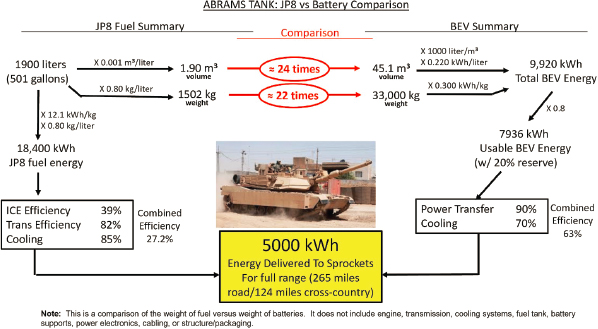
Abrams versus a JP8 fuel tank. Even if battery energy densities in 2035 reach two to three times today’s capability, the energy density advantage of fuel likely will not be overcome.
The analysis in Figure 6.3 shows that the problems with an electric tank are fundamental due to the significantly reduced energy density of batteries, both on a volumetric and gravimetric basis, versus JP8. However, up to 90 percent of the time, a ground combat vehicle is idling, therefore running a large kilowatt internal combustion engine (such as the Abrams’ 1100 kW) to generate just enough power to handle onboard electronics while stationary is inefficient and negates much of the advantage of JP8’s energy density advantage. The committee suggests that an auxiliary power unit of approximately 10 to 25 kW is the most efficient way to maximize JP8’s advantage during extended operations at idle. A 10 kW unit auxiliary power unit (APU) designed for the Abrams is already commercially available.
The electrical requirements to recharge each Abrams tank present an even more challenging issue (see Figure 6.4). An Abrams today can be refueled with JP8 on average in 6 minutes.22 As shown in Figure 6.4, to
___________________
22 A. Ernst, 2019, “Using System of Systems M&S to Assess Operational Energy and Inform S&T Investments,” U.S. Army Research, Development and Engineering Command, https://www.idga.org/events-tacticalpowersourcessummit/downloads/using-modelingsimulation-to-assess-operational-energy-and-inform-st-investments.
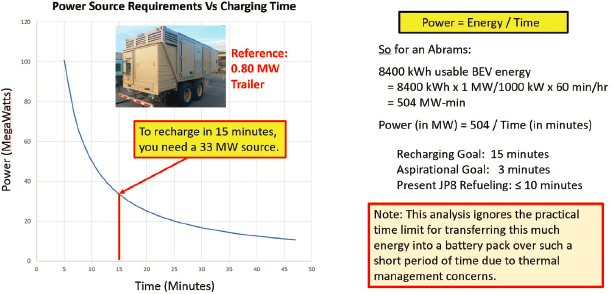
recharge each Abrams within a preliminary target of 15 minutes, a 29 MW electric source is required. It is unlikely that power sources of this magnitude will be found on the battlefield, as the Army’s MEP-PU-810 DPGDS Prime Power Unit (PPU) trailer is limited to 0.84 MW.23 Furthermore, if this power must be brought via a JP8 supply chain to generators near the front lines, additional inefficiencies accrue versus using the JP8 to run diesel engines directly for propulsion.
Internal Army studies at the Ground Vehicle Systems Center based on a more detailed analysis of a much lighter tank with anticipated vehicle improvements show similar results. Note that they are projecting that the battery pack for an all-electric tank using batteries with the same energy density as a Tesla Model S would weigh 60,100 lb and require a space claim of 605 ft3. This volume compares with a total allowance for an entire hybrid powertrain in a similarly sized tank of only 225 ft3. Furthermore,
___________________
23 M. Badr, 2017, “PD Power Systems, Inc. Receives a $1.1M Firm Fixed Price (FFP) Delivery Order for the Recapitalization of the Deployable Power Generation and Distribution Systems (DPGDS),” August 28, https://www.pd-sys.net/pd-systems-inc-receives-a-1-1m-firm-fixed-price-ffp-delivery-order-for-the-recapitalization-of-the-deployable-power-generation-and-distribution-systems-dpgds/.
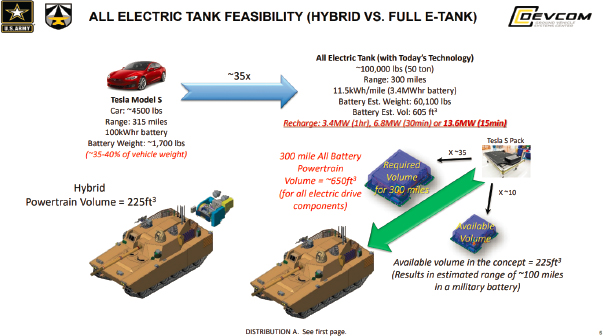
as shown, to recharge each such vehicle within 15 min, a 13.6 MW source would be required (see Figure 6.5). Thus, to recharge an Armored Brigade Combat Team with 28 such vehicles within an hour (i.e., seven charging at a time), a 95 MW power source connection of the right voltage and current would be required.24
BATTERY ELECTRIC TACTICAL VEHICLES
Similar to the above conclusions for armored vehicles, all-electric tactical vehicles have limited practicality on the battlefield, given their recharging requirements. For example, as shown below, the committee’s analysis showed that each Joint Light Tactical Vehicle (JLTV) would require roughly a 2.6 MW power source to recharge within 15 minutes
___________________
24 L.M. Toomey, 2020, “Combat Vehicle Energy Storage,” U.S. Army Combat Capabilities Development Command – Ground Vehicle Systems Center, http://www.usarmygvsc.com/wp-content/uploads/2020/02/Presentation-2-Energy-Storage_Toomey.pdf.
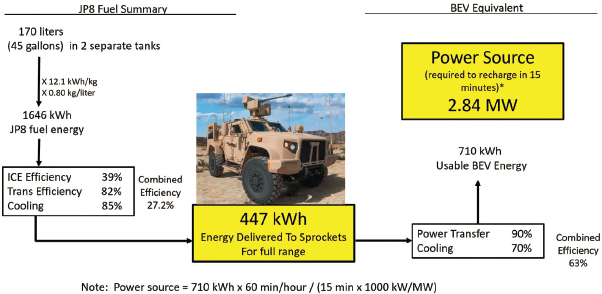
(see Figure 6.6). The Army has acknowledged this to be a major constraint on all-electric JLTV deployments.25
The Army is presently defining an All-Electric Combat Powertrain (AECP) demonstrator, which is intended to leverage learning from present and planned battery electric vehicles, such as the Tesla Class 8 truck and the AMEP program mentioned earlier. Projected 6.2/6.3 funding in fiscal years 2023–2027 is $74 million.26
Conclusion: The power requirements to recharge the batteries of an all-electric armored ground combat vehicle make an all-electric design impractical. Because of lengthy recharging requirements and the requirement for extremely large electrical power sources, extensive use of battery electric tactical vehicles (including those in a supply convoy) also
___________________
25 J. Koszewnik, and P. Schihl, 2020, Combat Ground Vehicle Propulsion Efficiency Discussion. Committee member original product featuring data from presentation delivered to the study committee.
26 P. Schihl, U.S. Army CCDC Ground Vehicle Systems Center, 2020, “Combat Ground Vehicle Propulsion Efficiency Discussion,” presentation to the committee, and email provided to individual committee member.
have limited practicality in a battlefield environment. The battery space requirements and additional weight limit all-battery vehicle use to select missions where silent operations are paramount and lengthy recharging times can be accommodated.
Recommendation: The majority of planned funding for the All Electric Combat Powertrain and any anticipated funding for battery electric tactical vehicles should be reallocated to work on series hybrid, parallel hybrid, and/or other partial vehicle electrification concepts. (Tier 2, Lead)
HYBRID COMBAT VEHICLES
As shown in Figure 6.7, the Army is studying a number of hybrid combat vehicles consisting of internal combustion engines, battery packs, motor/generators, and electronic controls. These vehicles would provide a limited range (3 to 10 miles) for battery-only operation, reducing the vehicle’s acoustic and thermal signature. In addition, because of their integral power electronics, such vehicles could provide significant external electric power to meet battlefield demands, such as providing power to microgrids or enabling recharging of battery systems for large weapon systems and/or multiple dismounted soldier power packs.
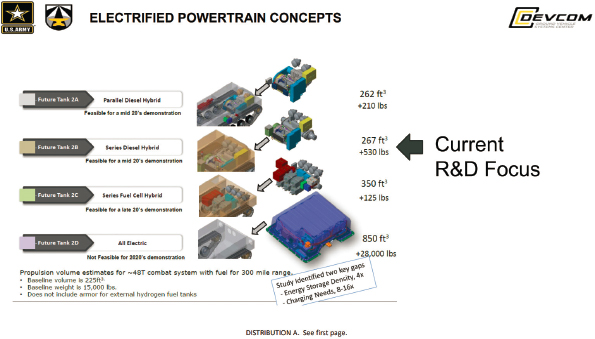
A major advantage of a hybrid combat vehicle versus a pure BEV is in time to refill versus the time to recharge required by an all-electric power plant. With a hybrid combat vehicle, the energy transfer is as quick as today’s vehicles, typically less than 10 minutes, and simply executed by filling up the tank with JP8. Note that this constraint is not a function of the C rate (recharging time) capability of the batteries. It is a constraint due to the enormous power required to transfer massive amounts of energy in a short time period.
IMPORTANCE OF RUNNING AT BSFC “SWEET SPOT”
Figure 6.8 is a brake-specific fuel consumption (BSFC) map for a modern diesel engine. For different engine speeds (shown on the x axis) and loads (shown on the y axis), it is possible to estimate the fuel consumption
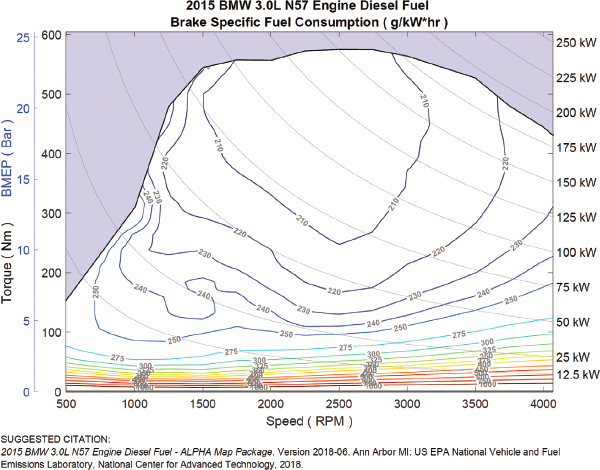
(typically expressed in units of grams per kilowatt hour). As shown, there is a “sweet spot” of optimal efficiency at 210 g/kWh where the least amount of fuel for a given work level is needed. Contrast that with the 300 to 1000 g/kWh fuel consumption shown at some of the lower load points that would be run when a vehicle is idling or moving slowly.
One advantage of a hybrid vehicle power plant is that the engine can be turned off whenever the battery storage maintains enough energy to sustain the immediate load requirement. When the load demand exceeds that for which the battery storage is capable, then the engine turns on. In this manner, a fuel economy advantage between 10 to 20 percent can be achieved based on military hybrids in production and previously planned (see Appendix K, “Hybrid Fuel Efficiency”).
Another advantage of particular importance to the Army is the hybrid’s ability to provide a “silent watch” and “silent mobility” capability for a limited distance using only stored electric energy with a significant reduction in its thermal and acoustic signatures.
SERIES VERSUS PARALLEL HYBRIDS
In a series hybrid configuration, there is no mechanical connection between the internal combustion engine and the wheels. The electric motor provides the only torque path to the wheels. The internal combustion engine in a series hybrid drives a generator, which in turn provides power to the electric motor and/or the battery energy storage. When energy to the electric motor is supplied by the battery pack, inefficiencies arise associated with its conversion into chemical energy and then back into electrical energy.
In a parallel hybrid configuration, both the internal combustion engine and an electric motor driven by battery energy storage can mechanically transmit power to the wheels. Power to the battery energy storage is provided by a generator driven by the internal combustion engine. The two torque paths can be linked together with a planetary transmission or with an upsized integrated starter/generator system.
An advantage of both hybrid configurations is the ability to run the engine in its BSFC “sweet spot” (see earlier discussion) most of the time. Another advantage common to both configurations is an ability to recover energy upon braking. Although this braking energy recovery should be possible in a wheeled vehicle, such as Stryker, it is unlikely in a tracked vehicle due to the enormous friction within the tracks. In a series hybrid configuration, only under high torque demand is electrical power provided by both the internal combustion engine generator and the battery energy storage. At such times, the internal combustion engine is not run at its “sweet spot.”
One advantage of a parallel configuration over a series configuration is its better fuel efficiency at higher loads. At such loads, the direct mechanical torque path from the engine to the wheels avoids some of efficiency losses incurred in a series configuration associated with charging and discharging the battery. It should be noted that with the addition of clutches disabling the mechanical torque path, a parallel hybrid configuration can be operated as a series hybrid, albeit with complexity and cost penalties.
As a result of the above considerations, the selection of an optimal hybrid system depends highly upon the intended duty cycle of the vehicle and the level of acceptable complexity or cost.
Recommendation: Continued engineering work on both series and parallel hybrids for the full complement of Army ground combat vehicles is strongly recommended because of the multiple benefits they provide. Although these studies can leverage work in the automotive industry, the specific needs of the Army (e.g., much heavier armored vehicles, less stringent emission standards) will result in significant differences. (Tier 2, Watch)
Recommendation: The Army should conduct a modeling and simulation analysis of different battlefield scenarios to define the optimal silent mobility range that is required for ground combat vehicles. The results will influence the size of the battery storage required and inform the optimum mix of research and development for parallel and series hybrid configurations. (Tier 1, Lead)
FUEL CELLS FOR VEHICLES
Solid oxide fuel cell (SOFC) power systems can be more efficient (up to 60 percent) in producing electricity than diesel or gas turbine generator sets (gen-sets) coupled with generators, depending on the fuel used. Because of higher efficiency, SOFC power systems can reduce vehicle fuel consumption. In addition, SOFC power systems produce significantly less noise than diesel or gas turbine gen-sets. The noise level of the SOFC systems is usually below 55 dB with only modest acoustic treatment, which is significantly below the noise level of typical diesel gen-sets (approximately 65 to 85 dB).27 Thus, SOFC power systems can provide sustained silent watch
___________________
27 G.J. Williams, A. Siddle, and K. Pointon, 2001, “Design Optimisation of a Hybrid Solid Oxide Fuel Cell and Gas Turbine Power Generation System,” ALSTOM Power Technology Centre, under contract for the DTI Sustainable Energy Programmes, https://www.osti.gov/etdeweb/servlets/purl/20249899.
capabilities for mobile platforms like Bradley Infantry Fighting Vehicles. Such SOFC power systems running on reformed JP8 fuel can be used as APUs on Army vehicles or as range extenders for electric vehicles.
Proton exchange membrane (PEM) fuel cells are the most suitable type of fuel cells for vehicular propulsion. As one example, Toyota and Hino will be delivering a class 8 PEM fuel-cell demonstration vehicle in 2021.28
However, these require hydrogen as the fuel. A worldwide emphasis is currently under way on generating and using large amounts of hydrogen to mitigate climate change. If hydrogen becomes practical and available in the field at some point in the future, PEM fuel cells can be considered for powertrains of Army vehicles.
A SUMMARY OF SILENT WATCH/MOBILITY OPTIONS
If the Army conducts force-on-force battlefield simulations and concludes that silent watch/mobility with a specific extended range is mandatory for at least some of their vehicles, the following options exist:
- PEM fuel cells. This power source requires bringing fuel to the battlefield in the form of compressed or liquid hydrogen. Recognizing that the fuel trucks will “cube out” before they “weigh out,” the disadvantage to hydrogen as fuel is that to provide an equivalent amount of energy to the field, the number of supply trucks will need to be increased by 4 to 7 times depending on whether they are bringing it in the form of liquid or compressed hydrogen, respectively. Local supply may be available as pure hydrogen fuel is rapidly making inroads in many world markets. So as just one example, if a conflict broke out in Eastern Europe, hydrogen fuel-supply trucks from Germany or Austria could be used to supply the battlefield.
- All-battery electric vehicles (BEVs). Due to the limited energy density of batteries, the range of a BEV would be severely compromised versus one equipped with an internal combustion engine. As discussed in this report, their biggest drawback, however, is their impractically long recharging times, along with huge electric power demands that far exceed what will be available even with micro-nuclear reactors.
- Hybrid configurations (using internal combustion engines). Based on committee discussions with the Army, such vehicles can have a
___________________
28 N. Bomey, 2020, “Why the Next Truck You See May Be a Quiet, Zero-Emission Hydrogen Fuel Cell Rig,” USA Today, October 26, https://www.usatoday.com/story/money/2020/10/26/hydrogen-trucks-nikola-gm-toyota-hyundai-zero-emissions/5981340002/.
- lengthy silent watch capability but will be limited to only 3 to 10 mi of silent mobility, even with anticipated battery energy density improvements by 2035.29
Force-on-Force Combat Modeling and Simulation Enhancements
As mentioned earlier, future power and energy studies could benefit greatly from a series of detailed battlefield scenarios against which various power and energy alternatives could be evaluated.
Previous studies have often taken power and energy availability for granted. For example, the assumed silent watch capabilities of Future Combat Systems were clearly inconsistent with the technology available at the time.30
It is worth noting that this is not necessarily a new insight, as a previous study by the Defense Science Board recommended “conducting realistic wargames and exercises that accurately reflect the threats to and capabilities of the joint logistics enterprise.”31
Recommendation: Given the importance of power and energy on overall operational capabilities, it is strongly recommended that the scope of future warfare computer simulations (i.e., tactical exercises without troops) be expanded to include power and energy considerations. These simulations should include identification of the quantity and form of energy to be transported to the battlefield, how much of this could be replaced with local sources, where it would be stored, any setup or takedown times, at what rate (i.e., power) that energy could be released, and how the energy needs of operating bases, vehicles, and dismounted soldiers would be replenished, including any refueling or recharging time requirements. When wargames are undertaken without computer simulation, a power and energy expert should be part of the evaluation team.
___________________
29 On the Abrams main battle tank, the complete power pack can be replaced when a repair is needed. Potentially, future ground combat vehicles could be designed with multiple “plug and play” power packs (electric/ICE hybrid, fuel cell, battery electric) that could be substituted for one another, thereby enabling the same ground combat vehicle to provide different performance attributes dependent on the specific battlefield mission profile.
30 C. Pernin, E. Axelband, J.A. Drezner, B.B. Dille, J. Gordon IV, B.J. Held, K.S. McMahon, W.L. Perry, C. Rizzi, A.R. Shah, P.A. Wilson, and J.M. Sollinger, 2020, “Lessons from the Army’s Future Combat Systems Program,” RAND Arroyo Center, https://www.rand.org/content/dam/rand/pubs/monographs/2012/RAND_MG1206.pdf.
31 Defense Science Board, 2020, “Task Force on Survivable Logistics: Executive Summary,” https://www.hsdl.org/?view&did=820550.



















